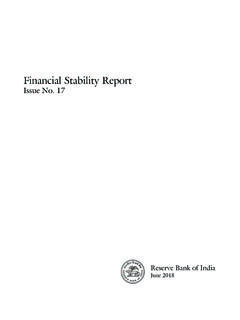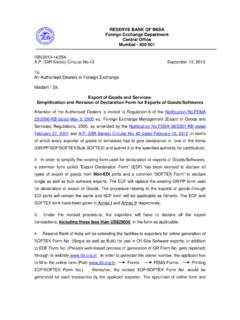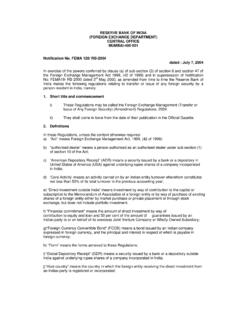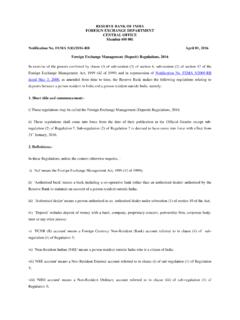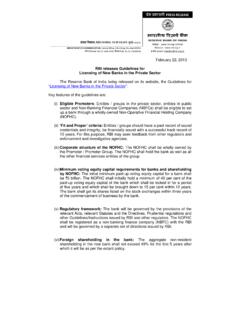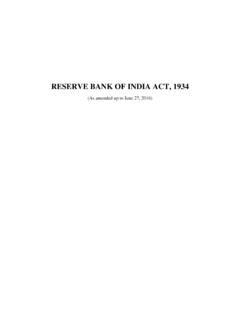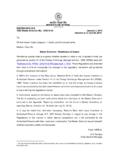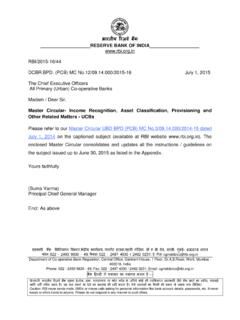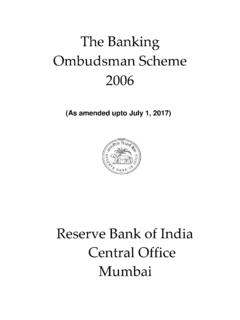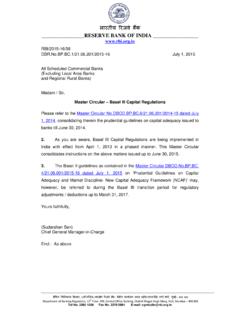Transcription of Taper 2022: Touchdown in Turbulence1
1 Taper 2022: Touchdown in Turbulence 1. Shri Juzar Khorakiwala, President, Shri Anant Singhania, Vice-President, Shri Ajit Mangrulkar, Director General, Shri Sanjay Mehta and Ms. Sheetal Kalro, Deputy Director Generals, esteemed members of the IMC. Chamber of Commerce and Industry, and friends, I thank you for inviting me to deliver the keynote address in the Thought Leadership Series. From the time of its establishment in 1907, the IMC Chamber of Commerce and Industry has always been a thought leader itself, with a membership base of above 5000 and over 150 trade associations affiliated to it. By providing vital inputs and recommendations, the Chamber plays a key role in shaping the contours of public policy making and debate on a wide range of issues that impinge on sustainable economic development. Hence, it is a privilege to be among you all and to share my thoughts. In the context of the recent challenging global developments and the overcast near-term outlook, I thought I will choose Taper 2022: Touchdown in Turbulence' as the theme of my address today.
2 Hawkish tones in systemically important policy pivots in early 2022. confirmed the worst fears of financial markets the age of abundant liquidity is drawing to a close. Financial assets, which were buoyed by liquidity into stretched valuations, are being re-priced. The ubiquitous acronym QE or quantitative easing is giving way to another QT or quantitative tightening in the lexicon of monetary policy. As central banks, the world's biggest buyers of bonds, prepare to turn into sellers, 1. Keynote Address delivered by Michael Debabrata Patra, Deputy Governor, Reserve Bank of India organised by the IMC Chamber of Commerce and Industry, Mumbai on March 11, 2022. Valuable comments from Sitikantha Pattanaik, Rajeev Jain, Binod B Bhoi, Abhilasha and editorial help from Vineet Kumar Srivastava are gratefully acknowledged. 1. their trajectory has been likened to landing on a short runway amidst fierce cross winds.
3 Now, as the drumbeats of conflict rise to a crescendo and economic warfare is unleashed, volatility is hitting high notes. Sudden shifts in risk sentiment and exodus to safe assets render financial markets shaken and stirred as investors struggle to re-assess this violent turn in the wind. Already snarled by supply bottlenecks, persistent high inflation and tightening financial conditions, the global economy is being dragged to the edge of a precipice. The immediate implications are expected to be lower growth, higher inflation and disruptions to financial markets. The longer- term implications are disruptions to global supply chains if physical infrastructure such as pipelines and ports are destroyed. If sanctions turn away demand, trade and investment, there could even be de- globalisation. Talk of stagflation has leapfrogged into the discourse on global economic prospects. The question that is uppermost is: will monetary policy still be tightened just enough to quell persisting inflation?
4 Or will it turn out to be excessive and snuff out the global recovery? Already high frequency indicators suggest that global growth is losing steam in the first quarter of 2022 with the surge and ebb of Omicron. Multilateral institutions expect that in the baseline scenario, the pace of global GDP growth may lose up to 2 percentage points over this year and the next. Private sector estimates indicate that if the price of crude rises to $150 per barrel, it will knock of another per cent of global GDP, while raising global inflation by another 2 per cent. 2. On one issue at least, there seems to be some certainty. Although monetary policy has a predominantly domestic orientation, the effects of the imminent shift in gears will not be confined domestically. It will spill over to emerging market economies, and it will spill back to systemically important ones. It is always easier to go into accommodation than to come out.
5 This brings back memories of 2013 and the infamous Taper tantrum'. It also focuses the spotlight on India. In 2013, India became one of the fragile five' economies that were roiled by financial market turbulence and, therefore, perceived as most at risk when tapering would actually begin. The Indian rupee or INR was among the worst affected currencies at that time, as foreign investors pulled out funds from emerging market economies as an asset class in anticipation of rising yields in advanced economy markets. Will this time be different? In the rest of my address, I propose to deal with this vexing subject head-on by assessing global macroeconomic and financial conditions then and now, the state of the Indian economy in terms of its underlying fundamentals, and the health of India's external sector which will bear the brunt of global spillovers. I will conclude with a few remarks on the way forward.
6 The Global Setting Global economic conditions in 2013 resembled those that are set to unfold in 2022. The global economy was weak then, with the recovery from the global financial crisis of 2008-09 still incomplete, and paths were diverging between jurisdictions. Advanced economies (AEs) were mending and gaining pace despite fiscal consolidation, but emerging market economies (EMEs) were slowing due to the tightening of external financing conditions. 3. The big difference was inflation. Commodity prices had fallen amidst improving supply conditions and, moreover, demand from key EMEs for commodities was subdued. As a result, both fuel and non-fuel commodity prices recorded small declines. The pick-up in growth in the AEs was not enough to pull in the slack in these economies and output gaps 2 remained large and negative. Consequently, inflation actually eased in AEs. In EMEs, on the other hand, the picture was somewhat similar to conditions prevailing today, with inflation turning out to be persistent and range- bound, and pushed up by the pass-through of currency depreciation.
7 Although monetary policy was in accommodative mode, financial markets were volatile amidst considerable uncertainty about the future course of monetary policy. In particular, markets were anticipating more tightening of US monetary policy than projected by the Fed and this was the factor that caused larger than expected spillovers. In EMEs, these spillovers interacted with underlying vulnerabilities, triggering capital outflows and a significant tightening of financial conditions in some of them, especially among the fragile five. As events unfolded, however, markets were found to be racing ahead of the real economy the Fed decided not to begin tapering in September, resulting in a modest easing of bond yields. Circling back to 2022, the global recovery is once again on a weak wicket edgy and prone to mishits. The omicron wave has taken its toll and there is growing evidence of loss of pace in the first quarter of 2022, as I alluded to earlier.
8 As in 2013, the paths for AEs and EMEs are diverging, with AEs expected to cross pre-pandemic trends while EMEs 2. The output gap is a measure of the difference between actual output and its potential level or trend. When actual output is above potential, demand is rising, and the output gap is positive. When actual output is below its potential, demand is weak, and the output gap is negative. 4. lag behind. Also, financial markets are highly volatile now, as they were in the fateful summer of 2013. War has added a whole new dimension to the outlook, and in fact, a weighty downside. With regard to other macroeconomic and financial conditions, however, 2022 and 2013 are studies in contrast. AEs are struggling with inflation at multi-decadal/record highs this year. In several EMEs too, inflation is way above targets, prompting them to be first movers in raising policy rates, with AEs following this time around.
9 In terms of financial conditions, it is sobering to keep in mind that the US Taper involved winding down a US $85 billion monthly purchase programme in a span of ten months in 2014. In contrast, a US $120 billion monthly purchase programme is being wound up in four months by March 2022. Before the commencement of the 2014 Taper , the Fed had expanded its balance sheet by around US$ trillion over a period of 64 months. In response to the pandemic, the Fed's balance sheet has expanded by US$ trillion in nine months from March to November 2020. It expanded another US$ trillion in the ensuing eleven months up to October 2021 and continued to grow till early March. Then, there is an elephant in the room in 2022, which is making the biggest inter-temporal difference. Financial markets reacted to the first missiles and air strikes on February 25 with a bloodbath across the world. Equity and currency markets tanked, and stampedes to safety lifted the prices of US treasuries, gold and the US dollar as also some safe house currencies like the yen.
10 These are externalities or spillovers which have been seen before, however. In fact, equity markets recovered towards the close of trading on the same day and through the next, although they sank again when fresh sanctions, including SWIFT exclusion, were announced on February 27. 5. There are some spillovers which we have not seen before. Commodity prices have been surging in a synchronized manner. Energy prices, in particular, are shattering what were widely regarded as glass ceilings. International crude prices crossed US$ 100 for the first time since 2014. With new rounds of sanctions, US$ 125-150 levels could be tested. Natural gas futures surged 50-70 per cent in Europe. benchmark prices of nickel, copper, aluminium and palladium are at their highest levels in a decade. Wheat and corn futures are at multi-year highs. The world is also bracing up for higher fertiliser prices and restrictions on energy supplies.
